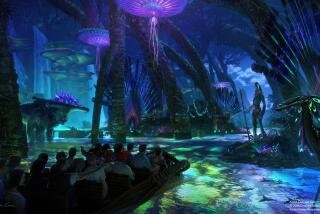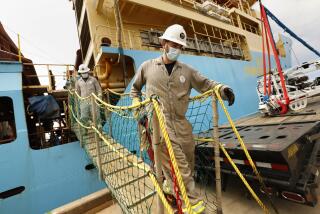Amid ‘Blackfish’ backlash, SeaWorld to expand orca environments
Reporting from San Diego — Battered by controversy over its treatment of killer whales, SeaWorld San Diego announced Friday that it plans to double the size of its orca environment, contribute an additional $10 million to research on the species and establish an independent advisory committee of scientists to oversee its orca program.
Called the Blue World Project, the new orca environment will be nearly double the size of the current facility, covering 1.5 acres at 50 feet deep and 350 feet in length. The new habitat will have 10 million gallons of water, up from 5.6 million.
The new pool will allow visitors to view the orcas from a 40-foot-tall glass wall below the water line, SeaWorld officials said in an announcement.
The new space, described as the first of its kind, is slated to be completed by 2018, officials said. SeaWorld parks at Orlando, Fla., and San Antonio, Texas, will follow with similar orca projects, officials said.
“Through up-close and personal encounters, the new environment will transform how visitors experience killer whales,” Jim Atchison, chief executive officer and president of SeaWorld Entertainment Inc., said in a statement.
SeaWorld San Diego has 10 orcas. The cost of the new habitat for them was not released. An underwater current will provide exercise for the orcas, officials said.
“Our guests will be able to walk alongside the whales as if they were at the shore, watch them interact at the depths found in the ocean, or a birds-eye view from above,” Atchison said.
The advisory group, whose goal, the company said, is to maximize the “health and well-being” of SeaWorld’s orcas, will include an emeritus professor at the UC Davis veterinary school, a researcher at UC Santa Cruz, a physiologist at the Scripps Institution of Oceanography in La Jolla, and others.
The additional $10 million will support projects sponsored by the National Oceanic and Atmospheric Administration into the hearing, reproduction and nutrition of orcas in the wild.
The new plans did not impress a main critic of SeaWorld’s orca program, People for the Ethical Treatment of Animals, which has called for the orcas to be put in large-scale ocean sanctuaries.
“This is a desperate drop-in-the-bucket move to try to turn back the hands of time when people understand the suffering of captive orcas, and it will not save the company,” said the group’s director of animal law, Jared Goodman. “A bigger prison is still a prison.”
The plan seems aimed at influencing the public and Wall Street.
The announcement, complete with statements of support from local elected officials, comes during a week in which SeaWorld’s economic picture took a nosedive and doubts were raised in financial markets that it can recover from the controversy sparked by the documentary “Blackfish,” which condemned the parks’ treatment of orcas.
On Wednesday, shares of SeaWorld Entertainment Inc., which has 11 theme parks, dropped 33% after the company’s earnings missed Wall Street expectations.
The Orlando, Fla.-based company also conceded for the first time that attendance at its theme parks has been hurt by negative publicity caused by a drumbeat from animal activists about the alleged maltreatment of the orcas.
At SeaWorld San Diego, the orca show at Shamu Stadium has long been the marquee attraction.
The company reported 6.6 million visitors at its parks in the April-to-June period, nearly flat compared with the same period in 2013.
Net income was $37 million, or 43 cents a share. Analysts had expected 60 cents a share. Sales fell 1% to $405.2 million.
On Thursday, Standard & Poor’s lowered SeaWorld Entertainment’s credit rating to BB- from BB, pushing the rate further below investment grade, also known as junk bonds.
“The negative outlook reflects our belief that the company faces significant challenges regarding reputational risk and potential improvements in operating performance beyond 2014,” Standard & Poor’s said in a statement.
Standard & Poor’s cited “negative media reports that have specifically targeted the company’s use of orca whales for entertainment purposes” as contributing to lower attendance and spending at the parks.
A bill by Assemblyman Richard Bloom (D-Santa Monica), now stalled in the Legislature, would ban the park from breeding its orcas or using them for “entertainment.”
The bill this spring was sent by an Assembly committee for “interim study,” an ill-defined process that could take a year or longer.
SeaWorld officials insist that its breeding program helps researchers study the orcas’ estrous cycles and gestation, and also “enriches the lives of our animals by allowing them to experience, interact with and help raise another member of their pod.”
Located on city property, SeaWorld San Diego attracts 4.4 million people a year and pays rent of more than $14 million a year to the city.
During the summer, the park employs 4,500 workers, putting it in league with Qualcomm, Northrop-Grumman and the Navy as a major San Diego employer.
Despite the controversy, political support for SeaWorld remains strong in San Diego. Earlier this year, the City Council voted to proclaim March as SeaWorld Month to celebrate the park’s 50th anniversary.
In a statement included with Friday’s announcement, City Council President Todd Gloria said he is “grateful to SeaWorld for the investment in these new facilities. The changes they’re announcing today will enhance the experience for the animals, workers, and visitors of the park.”
Follow the reporter on Twitter: @LATsandiego
More to Read
Sign up for Essential California
The most important California stories and recommendations in your inbox every morning.
You may occasionally receive promotional content from the Los Angeles Times.










